
 |
 |
 |
 |
 |
 |
 |
 |
Interbike show
Las Vegas, USA, September 26-30, 2005
Main Page Previous Part Next Part
Part 22 - SRAM's shifting revealed
SRAM steps up to the road with DoubleTap™
SRAM's entry into the road bike component arena has been the most significant tech story of the year and has had everyone scratching their heads about how the single-lever shifter can possibly work. Cyclingnews' North American Editor Mark Zalewski and tech correspondent James Huang lifts the veil after test-riding the new gear at Interbike.
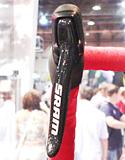
|

|
Component maker SRAM has given dominant player Shimano a run for its money in the mountain bike component area in recent years. While SRAM's shifting components are still not widespread on off-the-peg bikes, plenty of the company's Rock Shox forks and shocks feature on bike shop floors, along with its Avid brakes and Truvativ cranks. Meanwhile, SRAM transmission components are popular choices among riders upgrading or replacing parts.
Next year, SRAM will offer its first ever complete component group for road bikes, from its tried and true cassettes and chains all the way up to a brand new brake/shift lever design which will finally give riders a third shifting style for their road bikes. Cyclingnews was offered a first look at what SRAM hopes will be the next evolution in road bike technology.
For years, Shimano and Campagnolo have almost totally dominated road bike components, especially when it comes to shifting. The two have taken different approaches to the function of their shifting systems at the rider end. Both activate the shifting from the brake levers, but Shimano's STI uses a pivoting brake lever and inboard secondary lever whereas Campagnolo's Ergo-levers keep the brake lever independent and use a combination of a pivoting inside lever and thumb button. Since the advent of these designs, no company has been able to consistently offer an alternative - until now.
SRAM has been secretly developing this road group for the better part of two years, creating what amounts to a new division within the company. And by secret, we mean 'Area 51' secret, complete with confidentiality agreements and the like. But when you're challenging two of the biggest players in the bicycle industry, keeping secrets becomes vitally important.
Shifting the approach
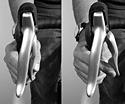
|
When the new shifters were first spotted and photographed at the USPRO criterium championships near SRAM's headquarters in Chicago, opinions on how the new shifting technology worked were as varied as flavors of ice cream. 'The lever moves out... no, it turns both ways... no, you fool, there must be a second button!' Once the levers were unveiled for semi-close inspection at the trade shows, the appearance of just one shifting-specific lever made everyone scratch their heads.

|
The inside skinny is that the one lever that's tucked behind the brake lever does indeed perform both shifts - which shift you get depends on how far you push it.
SRAM calls the new shifting style 'DoubleTap™,' since the lever has a double movement for shifts. This is possible thanks to a new internal shifter design coined 'LeapFrog™,' where the internal cams and sprockets can move up or over each other to advance up or down the cluster. This is all dependent on how far the internal lever is moved.
The action breaks down like this:

|
To control the rear derailleur, the inside lever is moved inwards, somewhat similar to Campagnolo's and Shimano's designs. But this is where the similarities end. A small movement inwards stops at an index, where the user must make a decision -- either release the lever and move the chain to a smaller/harder cog in the rear, one cog at a time -- OR keep moving the lever past this index point to move the chain up to a larger/easier cog, from one to three cogs at a time.
For the front derailleur, the lever moves similarly, with a push and release to move to the smaller ring and a two position movement to shift to the larger ring. The action is vaguely similar to the Shimano shifting action, but is achieved through just one lever. This multi-stage action in one lever is where the DoubleTap™ name originates.
Taking a look at the internal mechanism inside the shifter, the simplicity of the design is quite remarkable. For shifting to a harder gear, a claw moves up the sprocket one tooth at a time. But for shifting to an easier gear (moving the lever another index inwards) the claw is lifted back over itself, from one to three teeth, depending on how many indexes over which the lever travels.

|
At first glance, this new approach to shifting has some possible advantages, particularly addressing the common disadvantages many people find with the other shifting designs. SRAM has done a good job at taking what has worked in the past and incorporated it together with new ideas. First, there is only one shifting lever that does both jobs, and does them both moving in the same direction. Since it is the smaller lever, it moves rather easily, with shifts achieved over small amounts of lever travel. More importantly, it is equably accessible and usable with your hands positioned in the drops or on the brake hoods. This point should solve many issues for people who like to shift from multiple positions.
Another advantage is that the cabling is all internally routed, similar to the Campagnolo design. This provides a nice, clean handlebar area for the rider and addresses the most common criticism of Shimano's STI, the untidiness of external cables. The shifters themselves are rather comfortable, and they better well be since SRAM says it has painstakingly researched the proper shapes, sizing and materials to make the most ergonomically comfortable hand position. The material is similar to the grips on fighter pilot controls and the shaping of the hoods allows for closer-to-neutral position. This should eliminate hotspots on a rider's hands.
Okay, but does it really work?
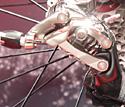
|
The short answer, yes. On a trainer at least. During Cyclingnews' first peek, I got a test ride on the new group with a bike set up on a wind-trainer. After a quick demonstration, I eagerly jumped on the bike to see what this new shifting would feel like. The first thing I noticed was that the brake hoods, where I ride 80% of the time, were rather comfortable. Now I didn't get to spend six hours riding on them, but I imagine they would provide a good place of support for those longer rides and races.

|
After turning the pedals a few times, I pushed the internal lever the short distance to the first index point. I held it here for a few seconds to see if anything would happen before I chose... nope, not until I decided to go up or down. I released the lever and the chain moved smoothly down to a harder gear. At this point, I put the whole cluster through the quick up and down test, moving the gear to the hardest and then seeing how fast I could get back to the top. The shifting action was crisp and decisive, with the up-shifting able to jump three at a time. Going back the other way, the short distance the lever goes to the first index position allows for rather quick downshifting -- a necessity when sprinting against Robbie McEwen in the Tour or your best friend for a beer.
Speaking of sprinting, the SRAM people were eager to show us that this new design can be used in a variety of ways. One way they found particularly useful was to sprint with the shift lever pulled up against the handlebar drop. This is possible since the lever is completely independent of the brake lever. With the hand holding the lever against the drop, the rider need only twist the wrist slightly and back to achieve the first index point, shifting to a harder gear. This particular application of the new design was brought to the attention of SRAM by one of the early testers at the USPRO criterium championship -- showing that bike companies to value the feedback of the pro riders who use their equipment.
The rest of the group

|
SRAM will be releasing two complete groups to complement the new shifter technology. Each will consist of seven components unique to each group and will include shifters, front and rear derailleurs, cranksets, cassettes, chains, and brakes. The top-tier group is said to be Dura-Ace/Record quality, while the other is said to be more along the lines of Shimano's Ultegra.
The top-level derailleurs look to be nicely finished with wide-spaced pivot links and abundant use of highly polished alloy and carbon fiber. From the appearance, expect both front and rear units to be admirably stiff to ensure precise shifting.

|
The crankset is a bit of a departure from SRAM's previous carbon cranks in that it no longer has a separate alloy spider - that design has practicqally vanished from high-end cranks as manufacturers have found ways to incorporate a carbon spider into the mould. The large-diameter chromoly spindle and externally-mounted bearings borrowed from Truvativ's Giga X Pipe system should provide ample drivetrain rigidity.
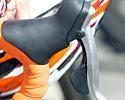
|
The brakes mark another first from SRAM in that they are the company's first caliper brake designed in-house. Cold-forged aluminum construction is used here as well, and the reinforcing strut should provide a solid feel at the lever.
Cassettes and chains are mostly adaptations of SRAM's current offerings. Of note, however, is the top-tier cassette, which will use an anodized aluminum spider to carry the largest cogs, similar to what was introduced recently for their new off-road cassettes.
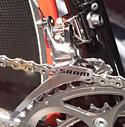
|
Finally, all of the road components will likely bear the SRAM logo exclusively, including the brakes and cranks, which typically would have been Avid and Truvativ offerings, respectively. For the road groups, SRAM apparently felt the need to imbue the parts with a sense of cohesiveness that is often no necessary to the off-road set.
Unfortunately, SRAM wasn't able to let me take this new equipment out on the road to see how it performs under 'real world' conditions. And I was not able to get a good sense of the stopping power behind the brakes and brake lever. However, SRAM's track history in mountain biking indicates that the company knows how to make equipment that works in tough conditions, and the time and resources that have gone into this project strongly implies that all parts of this design have been tested, tweaked and tested again. The next hurdle is to see how they perform on the bikes of professional teams next season, which SRAM is currently negotiating.
Photography
For a thumbnail gallery of these images, click here
Images by James Huang/Cyclingnews
- The shape of SRAM's lever hoods seemed comfortable enough on the trainer, but we'll see for sure later on. And contrary to speculation, there is just a single lever used to initiate shifts in both directions.
- The frontal view of SRAM's new road shifters highlights the radical shape they take in the name of ergonomics.
- A reinforcing brace is neatly integrated into SRAM's new upper-level road caliper and should minimize flex for a solid feel at the lever.
- SRAM's new crankset is its first all-carbon offering that doesn't incorporate an alloy spider. The external-bearing Giga X Pipe is carried over.
- The new front derailleur uses cold-forged aluminum links with widely spaced pivots to minimize cage deflection during shifts. Speaking of the cage, it looks to be steel rather than alloy for durability.
- A glance at the cable path underneath the rear derailleur suggests that SRAM may be doing something a little different with their cable pull ratio. Word has it that it's not quite along the lines of their 1:1 system from their mountain bike componentry, though.
- The rear derailleur - Like the front derailleur, the rear looks to be constructed mostly of forged alloy. Of course, though, there is a healthy smattering of carbon tossed in for good measure.
Images by SRAM
- A new shift position for sprinting - SRAM's road group has multiple positions for shifting, including this unique way of shifting while sprinting in the drops.
- Shifting from the drops - the long shift lever is easy to reach from the rops.
- Shifting from the hoods - little effort is needed to tweak the shifter across from the tops of the lever.
- The angles at which different shifts are achieved.
Images by Mark Zalewski/Cyclingnews
- Where it all began - SRAM's shifters made their first appearance at the USPRO criterium championships in August, but had been under development for two years before that.